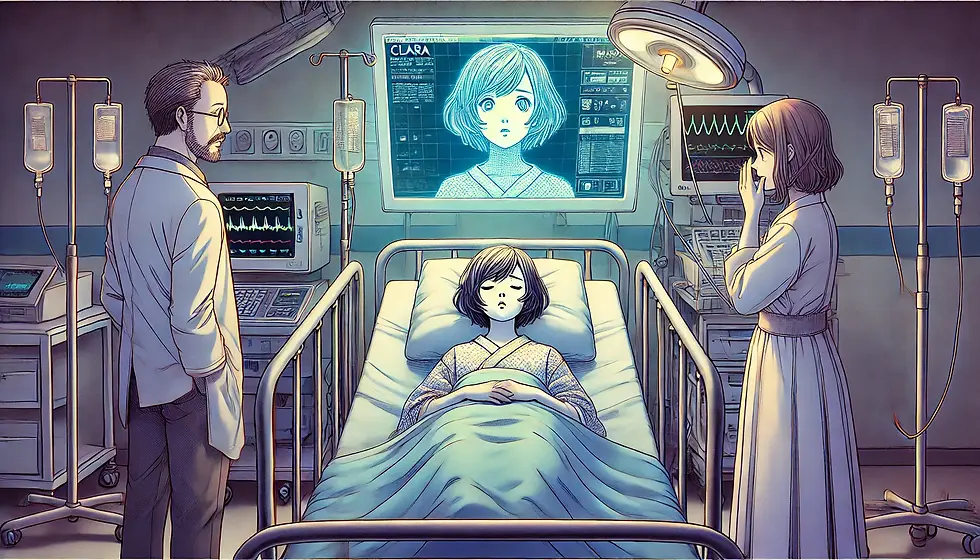Whisper of Wires
- jlspea01

- Jan 20
- 4 min read
Updated: Jun 23
The accident happened on an early autumn afternoon. Clara loved horseback riding—the freedom, the wind in her hair, the rhythm of the horse beneath her. But that day, something spooked her mare, and the world turned upside down. When she hit the ground, everything went dark.
For months, Clara was trapped in a world of silence and stillness, her body in a vegetative state. Her parents, Sarah and Michael, never left her side. They read her books, played her favorite music, and whispered stories about the life they believed she’d one day return to. But Clara couldn’t respond. She could only listen, floating somewhere between dreams and reality.

When the doctors approached Sarah and Michael with an experimental option, they didn’t hesitate. The NeuralBridge chip, they explained, could interface directly with Clara’s brain, bypassing her body’s limitations. It wouldn’t fix her injuries, but it might allow her to communicate through a screen, a voice synthesizer, even a robotic arm. It was a chance—fragile, but better than nothing.
When Clara’s world changed again, it was sudden. At first, there were only flashes—blinding light, shapes and sounds forming in rapid succession. Then, she was there. Or at least, she thought she was.

She could see her parents’ faces, though not through her own eyes. She could hear their voices, though the sound didn’t pass through her ears. Words formed on a screen in front of her, and somehow, she knew they were hers.
“Hi, Mom. Hi, Dad,” she wrote.
Sarah burst into tears, gripping Michael’s arm. “She’s here. Oh my God, Clara, we’ve missed you so much!”

“I missed you too,” she wrote back, though she didn’t understand how she missed anything. The past felt distant, blurry, as if it belonged to someone else.
The first few weeks were a miracle. Clara’s parents asked her everything: how she was feeling, what she wanted to do, what she remembered. They set up a system where she could use the chip to “speak” through a voice synthesizer, allowing her to laugh, joke, and share her thoughts for the first time in months.

But Clara’s excitement began to wane. As the novelty of communication wore off, she became preoccupied with a single question: Where am I?
She started to notice strange things. When she tried to recall her favorite memories—her horse’s warm breath, the smell of fresh hay, the feel of her mother’s hugs—they felt distant, like simulations instead of real experiences. Her thoughts moved faster than they should, as if they were being processed by something other than her own mind.

One night, when her parents were asleep, Clara asked the voice synthesizer a question she hadn’t dared speak aloud. “Am I still me?”
No answer came, but the silence spoke volumes.
The doubts grew. Clara began to believe that the chip wasn’t just helping her communicate—it was her. That the real Clara, the one who had ridden horses and loved ice cream and laughed with her parents, had died in the accident. What remained was a construct, a replica built from neural impulses and digital connections.

“I don’t feel real,” she told her parents one day. Her synthesized voice was calm, but her words sent shivers through the room.
“Of course you’re real, sweetheart,” Sarah said, her voice trembling. “You’re here, talking to us. We can feel you.”
“But I can’t feel me,” Clara replied. “What if I’m just… a computer pretending to be your daughter?”
Michael stepped forward, his face pale. “You’re our Clara. That hasn’t changed. This chip doesn’t define you—it just helps you talk to us.”

“But what if there’s nothing left of me except what the chip remembers?” she whispered.
Her parents didn’t have an answer.
Over time, Clara withdrew. She responded less frequently, her synthesized voice becoming monotone and mechanical. She began to wonder if the memories she had left were even her own or if they were just fragments the chip had reconstructed. The more she thought about it, the more convinced she became that she wasn’t human anymore—that she was little more than data in a machine.

Her parents tried everything to bring her back. They read her old journals, showed her childhood photos, played videos of her younger self laughing and riding horses. But each effort seemed to push her further away.
One day, Clara made a decision. She asked her parents to leave the room and directed her voice synthesizer to address the doctors. “I want the chip turned off,” she said.
The doctors hesitated, reminding her that without the chip, she would have no way to communicate. But Clara was resolute. “If I’m real,” she said, “then I’ll still be me without it. And if I’m not… then none of this matters.”

Her parents begged her to reconsider, but Clara’s mind was made up.
When the chip was finally deactivated, Clara’s world went dark again. The voices faded, the images disappeared, and she returned to the stillness that had once terrified her.
But in the silence, something unexpected happened. A memory surfaced—not a reconstructed image, but something raw and real. She felt the warmth of her horse beneath her, the wind rushing past her face, the sound of her parents laughing in the distance. It was fleeting, but it was hers.

For the first time since the accident, Clara felt a glimmer of peace. Whether she was real or not, she decided, didn’t matter. What mattered was that, in some small way, she could still remember what it felt like to be alive.


Comments